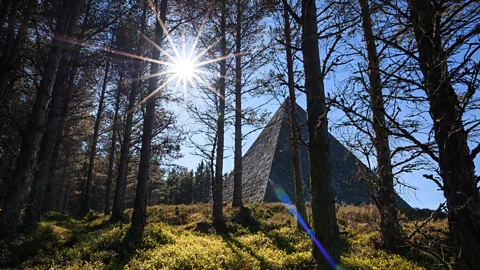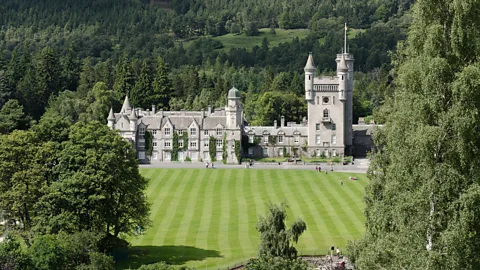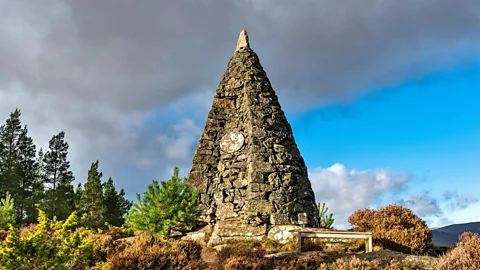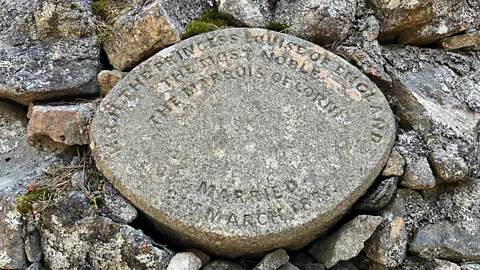The secret royal 'pyramids' of Scotland
 Getty Images
Getty ImagesTucked deep in the woods of Balmoral, the Scottish royal estate beloved by Queen Victoria, lie 11 little-known memorial cairns – including one massive granite pyramid. Built to commemorate royal milestones and loss, they tell a quiet story of love, grief and nation building.
When Queen Victoria first visited Balmoral Castle in rural Aberdeenshire on 8 September 1848, six years after her first visit to Scotland, she took time out to appreciate the woodlands, gardens and rippling mountains.
Perhaps she deeply breathed in the Caledonian pine air. Perhaps a deer stood motionless, caught in her gaze. Certainly, she saw a different future for herself and her husband, Prince Albert, on Deeside in the Highlands. "All seemed to breathe freedom and peace, and to make one forget the world and its sad turmoils," she recorded in her diary. Soon after, the baronial estate became a mainstay for the rest of her life – and it remains a sanctuary for the British Royal Family to this day.
There are many stories hidden at Balmoral Castle, but perhaps none so intriguing as that of the estate's secret "pyramids", or memorial cairns. There are 11 of these, strewn almost negligently around the near-50,000-acre estate. The largest is a stone monolith more in keeping with the design of the great dynastic structures of Ancient Egypt than anything Scottish, while the smaller ones are scattered like clues to a greater mystery. And seeking them out – on a hunt akin to an Indiana Jones-type treasure hunt – is a little bit of everyday magic hidden among the Scots pine, firs and hemlocks.
Like many visitors to the Royal Deeside, I'd been to the country's best-known estate before. Located in the eastern Cairngorm mountains, the turreted 167-room castle, ballroom, mews courtyard, sunken garden and thistle-shaped maze are a bonanza for visitors, especially between April and early August when the full grandeur of the castle is open to ticketed visitors. There are around 80 residential properties on the wider estate, too, plus commercial forestry plantations, a hydroelectric dam, facilities for deer stalking and grouse shooting and a golf course.
 Alamy
AlamyBut following the Covid-19 pandemic, when locals were forced to stay closer to home and making nearby discoveries became the national habit, the unlikely memorials appeared on social media posts like whispered secrets. Balmoral estate is 100 miles from where I live in Edinburgh, so I had lodged them in my mind as a rewarding challenge to track down the next time I was in Aberdeenshire.
Why were these marvels created? According to Ewen Cameron, professor of Scottish history at the University of Edinburgh, most were commissioned by Queen Victoria to commemorate significant events in the lives of her family, including the marriages of her nine children. The cairns commemorate Prince Albert Edward, Princess Alice, Prince Arthur and Princess Beatrice among others, forming a kind of family map across the forested hills.
Plan your trip:
- The Balmoral cairns walk takes around three hours, covering six miles.
- Walk Highlands' easy to follow Balmoral Cairns map gives a step-by-step guide to tracking down eight of the cairns on one continuous circuit. For a shorter walk, follow the Blue Route path, which will take you to five cairns.
- The best starting point is from the car park at Crathie (£5 parking charge). Cross the Crathie suspension bridge then enter the estate along a private road close to the Royal Lochnagar Distillery.
- You need a ticket to enter the immediate grounds of Balmoral Castle (£18.50 for adults, £9.50 for children), but the wider estate can be accessed for free along various private roads and forest tracks.
- Balmoral Castle and Estate are closed to the public when the Royal Family is in residence (usually in August).
"Princess Louise's cairn has perhaps the most interesting backstory," said Cameron, whose research includes Scotland's post-union history from the 1700s onwards and the politics of Highlands' land ownership. "She was the sixth child and fourth daughter and married John Campbell, the 9th Duke of Argyll, and this helped strengthen the family's ties to the Highlands, which was so important to Queen Victoria. There's a certain irony that a descendant of the House of Hanover was in thrall to this romantic idea of Scotland too."
Another marker came after the death of Prince Albert in December 1861. This saw the arrival of the estate's largest cairn, in the shape of a pyramid cut from granite, explained Gordon Casely, a respected heraldist and former journalist interested in the myths and legends of the north-east. Tucked away at the top of Craig an Lurachain hill with a stunning panorama of the surrounding Cairngorms National Park, it requires the most effort to reach and is now often dubbed "the Great Pyramid of Scotland".
 Alamy
Alamy"The cairns are a fabulous, if unlikely, addition to the estate," Casely said. "They're absolutely intriguing, as each one has its own backstory and design, and I'm not surprised more visitors are seeking them out. Their legends are worth telling."
Setting out from the Balmoral car park at Crathie, just east of the town of Braemar, I shouldered my backpack and entered the dark of the estate's woods to see all of these silvery-stone creations for myself. An ancestral path climbed high above the silvery River Dee then rollercoastered over thick roots and fell into a sharply cut glen. Every tree branch helped blot out the early summer Sun, and the only sound was birdsong.
The first cairns I found were Princess Helena's, soon followed by Princess Louise's on a yawning gap atop a rocky outcrop. Next came the Purchase Cairn, built in October 1852 to commemorate the purchase of the Balmoral estate from members of Clan Farquharson by Prince Albert. That it was the first memorial erected still holds significance today: the twisted forest is a maze, and the cairn's lofty outlook on the summit of Craig Gowan makes it by far the easiest to track down. It also captures one of the finest views of Royal Deeside.
What many don't realise is the cairns might well have ended up elsewhere. In the mid-1800s, Queen Victoria and Prince Albert visited a number of Highland estates before alighting on Balmoral. For a time, the royal couple even considered buying Ardverikie estate, which overlooks Loch Laggan on the far western side of the Cairngorms. For them, Cameron mused, it was perhaps too hard to get to, even for the Highlands. The alternative – Balmoral Castle – was leased in 1848, before the full estate was purchased four years later.
 Mike MacEacheran
Mike MacEacheran"Balmoral… was out of the way, but not too much," Cameron explained. "It had everything. The rugged Highlands' scenery, the River Dee, the mountains, and the Queen had imbibed this increasingly romantic idea of what Scotland was. Balmoral also became very useful to her after Albert's death in 1861 – she was in a kind of purdah after he died, aged only 42. It provided her with a sanctuary from the world."
Hunting down the cairns is a journey into that past – and into the very idea of Scotland as shaped by Victorian ideals. Queen Victoria was responsible for what has been labelled the "Balmoralisation" of the Highlands, and, as Cameron told me, the idea is still very alive in the minds of many of those who visit.
"Scotland has long been pitched as an empty, wild, romantic place – even though we Scots know it's not," he said. "That idea has carried on through the centuries, whether through the influence of a writer like Sir Walter Scott or the art of Edward Landseer, a favourite painter of Queen Victoria, whose most celebrated work, The Monarch of the Glen, is a potent romanticisation of the deer-filled landscapes like Balmoral."
Today, for interested visitors, that royal commission-turned-nation-defining painting is on display at the National Galleries of Scotland in Edinburgh.
 Mike MacEacheran
Mike MacEacheranBack in the woods, my journey continued through this largely unchanged landscape, along six miles of meditative woodland trails in the company of red squirrels and an osprey, before, finally, the path began to climb steeply uphill. Then the trees opened onto a memorable scene: the near-11m-high Prince Albert pyramid overlooking all of Royal Deeside. The view was the archetype of beauty in nature: romantic and wild, just as it was when Queen Victoria first raised her royal banners there. The pyramid, stark and stony, is an unlikely version of the Highlands from the one that so many dream of.
Even in a country home to a trove of ancient stones, Neolithic sites and mysterious histories, this Victorian cairn is still a marvel. Approaching it and the other cairns on foot, alone and in silence apart from droning insects and birdsong, has the effect of making them even more bewitching – especially when seen in brilliant sunlight, under an uncommonly saltire-blue Highland sky.
--
If you liked this story, sign up for The Essential List newsletter – a handpicked selection of features, videos and can't-miss news, delivered to your inbox twice a week.
